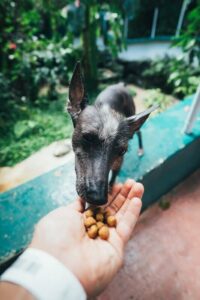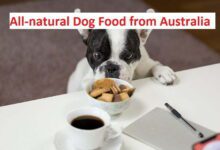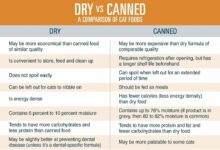
food fresh if you have a cherished pet dog
food fresh if you have a cherished pet dog You recognize exactly how vital it is to maintain their food fresh if you have a precious animal
They will certainly assist you conserve cash by purchasing the larger bags of food as well as being able to maintain the food fresh in a family pet food storage space container.
There is a broad selection of storage space containers, such as soft family pet food storage space items and also automated pet dog food dispensers with storage space ability.

You can acquire layouts that are fashionable adequate to keep your pet dog’s food out in the open. If you choose to keep your pet dog’s food outside, however do not desire to spoil the landscape, you can also buy pet food storage space containers formed like rocks.
They usually have a put chute at the base of the container that will certainly make it much easier for you to put the food right into your animal’s dish. One more alternative that is much easier on the eyes is a wood family pet food storage space container with a hinged cover.
An additional kind of pet dog food storage space container can be piled. They typically hold concerning 100 extra pounds of pet dog food as well as if you ever before require to include even more, you can merely pile it on top of the various other one.
Maintaining your pet dog’s food fresh is the number one factor you desire a great container. Animal food storage space containers can do this all for you.
They will certainly aid you conserve cash by purchasing the larger bags of food and also being able to maintain the food fresh in a pet dog food storage space container.
There is a vast selection of storage space containers, such as soft family pet food storage space items as well as automated animal food dispensers with storage space ability. You can make use of these animal food storage space containers for both canine as well as feline food.
If you favor to save your pet dog’s food outside, however do not desire to wreck the landscape, you can also acquire pet food storage space containers formed like rocks.
Tail-Wagging Trends: Four-Legged Family. Members Enjoy Pet Food With Epicurean Polish
For many people, the estimated 73 million dogs in America aren’t just pets, they’re family members. In fact, according to the American Pet Products Manufacturers Association (APPMA),

78 percent of owners consider their dog an “equal member” of the family. Thus, pet parents want to ensure their dogs are not only healthy-but happy.
The latest innovations in pet products and services evidence the growing humanization of pets trend-from couture clothing,
puppy showers and spa treatments to new family-style food for dogs made with real, wholesome ingredients. In 2005, more than $35.9 billion was spent on pets in the U.S., $14.5 billion of that on food alone.
“One of the biggest trends we’re seeing among pet owners is the desire to feed their dogs the way they feed themselves-choosing food that is made with real,
high-quality ingredients that offer the perfect balance of taste and nutrition,” says Steve Crimmins, vice president of dog food marketing for Nestlé Purina PetCare Company.
To meet this demand, Beneful brand dog food, one of the most successful premium dog foods on the market, looked to highly involved pet owners to create their ideal dog food from virtually a farmer’s market buffet of real ingredients.
Beneful nutritionists then adapted the recipes to ensure they provided complete and balanced nutrition for dogs and puppies.
The result is the introduction of the first-ever prepared meals for dogs that add epicurean polish to pet food. Beneful® Prepared Meals™ offers family-style food for dogs made with real,
wholesome ingredients including succulent real meat and poultry, wild rice, barley, pasta, spinach, green beans and carrots.
The new pet food is available in eight varieties that are packaged in a clear, ready-to-serve, resealable plastic container-a packaging first in the pet food industry.
Now pet owners can see the quality of the product they are purchasing in the pet food aisle and the difference is clear.
Natural Foods For Your Dog
Natural dog foods provide premium nutrition that is very much essential to maintain health, performance and vitality of the dog. These natural dog foods give strength to your dog.
If you want your dog to remain happy and healthy then you must give natural dog foods.
Dog food manufactured by these companies is reliable, consistent and safe.
A very high standard is used in manufacturing these natural dog foods. These companies are dedicated to manufacture good quality natural dog foods.
Quality control should be given the highest priority while preparing natural dog foods.
Food ingredients should be meticulously selected while preparing natural dog foods.
Good natural dog foods promote optimal health of your pet. If you really care about your dog’s health then natural dog food is a must.
There are many companies manufacturing healthy natural dogs food. If you have inadequate information about these companies then you can take the help of the internet. There are websites that provide information about the companies that manufacture natural dog foods.
Regular intake of natural dog foods will make your dog’s skin and coat shiny, soft and dander free. Your dog’s noise will be clean and damp, eyes will sparkle. You dog’s aroma will definitely improve.
Goodness associated with natural dog foods will indeed satisfy the nutritional requirements of your pet dog. Natural dog foods also have good taste. These foods act like a protective covering against several dog diseases.
The formula for making natural dog foods is based on organic grains and ground free organic chicken. It contains whole, raw vegetables and fruits.
These fruits and vegetables consist of health promoting nutrients, phytochemicals and antioxidants. All dog food products that are labeled organic should contain more than 95% of certified organic ingredients.
Sea salt is a common ingredient found in natural foods. It contains essential nutrients such as chloride and sodium. Sea salt is a major source of sodium. Lack of sodium may lead to serious kidney and heart problems.
Feeding a chloride deficient food to your pet may lead to nervous system problems. These foods also contain natural flavors which do not contain artificial or synthetic components.
In general natural dog foods contain natural ingredients that include rice protein, brown rice, oats, barley, whole wheat, butter, quinoa, natural flavors
Excessive quantity of sodium should not be used to increase the palatability of the food.
Natural dog foods contain the necessary vitamin that regulates metabolism of your pet’s body.
Although natural dog foods are available throughout the world, the Canadian and Australian natural dog foods are famous and are more preferred.
Dogs having natural dog foods are energetic. You absolutely don’t have to worry about your dog’s health if your dog is feeding on natural dogs food.
If you want your dog to stay healthy everyday then you must provide your pet with natural nutrients which are in natural dog foods.
Natural dog foods are easily available in the market and are affordable.
So next time you decide to feed your dog, don’t forget to give natural dogs foods which are a reservoir of nutrients.
Choosing Healthy Foods For Your Dog
Today’s pet food market is larger and more diverse than ever before. While this offers a large number of choices in various types of pet food, it also presents a dilemma in choosing the healthiest food for your dog.
Are generic or store brands suitable for a dog? What about familiar name brands like Purina and Alpo? Are the pricier brands that advertise specially formulated ingredients (Science Diet, Eukanuba)
really living up to their claims and worth the extra money? All of these are valid questions that loving dog owners deserve to have answered.
Dog Food Considerations
There are several factors to consider when choosing the right food for your dog. Different dogs have different nutritional needs at different stages in their lives. Some things to consider when selecting the food you’ll give your dog follow.
• The Dog’s Age
Puppies have different nutritional requirements than adult dogs just as human children have different needs than adult people.
Senior dogs also have different requirements than younger adult dogs. Make sure that you select a food that is appropriate for your dog’s stage in life.
• The Dog’s Health
Does your dog have a specific medical condition? If so, the food you choose may need to be partially dictated by that condition.
Diabetic dogs need low-glucose foods and dogs with specific allergies (yes dogs can be allergic to all sorts of things, just like people) may require certain foods as well. Your veterinarian can help you choose foods that are appropriate for a dog with a specific medical condition.
• The Dog’s Size or Body Type
Some dogs are overweight. Some dogs are underweight. Some have a natural tendency to get lots of exercise while others tend to prefer to lie around a lot. There are, of course, small, medium, and large dogs as well as the ultra-tiny “toy” dogs.
All of these different types of dogs will have different requirements for the type of food they need as well as how much of it.
• Your Budget
Dog food can be expensive, there’s no doubt about it. And where dog food is concerned, the rule really is “you get what you pay for.”
Low cost generics and store brands will lighten the burden on your wallet, but may not be the healthiest choice for your dog as they are made with cheap ingredients and lots of fillers. You should buy the best dog food you can on your budget to help ensure your dog’s nutrition.
Letting Your Dog Choose His Own Food
Spend time at any pet store and the choice of dog foods to feed your dog is in abundance. How do you know which to choose and which is good for your dog?
The answer to that is simply, you do not, let your dog choose. Although there are some basics that are recommended.
If you have purchased your dog from a breeder, ask the breeder what they recommend to feed your new pet. A good breeder should be able to tell you what has worked best for their dogs.
This is a good place to start. However, if you have adopted your new dog, then it will be up to you to figure out what is good for your dog and what is not. The dog will certainly help you in determining the right food for him.
Always read the labels on a dog food package. What you want to look at is the first ingredient. You do not want to see meat meal, this can be anything within the food including road kill.
Chicken Meal or Lamb Meal is a good start. You also always want to see the word meal; whole meat without the Meal is mostly water. Most nutritionists prefer chicken based dog foods as they are easier to digest.
You may see corn or a type of corn product in the dog food. Corn is a protein source the dog food makers use to keep the price reasonable.
Some dogs like corn and others do not. If you see your dog start itching, licking his feet, scooting his butt, or getting frequent ear infections, this could indicate a lack of tolerance for corn. Beware of wheat in a food. Wheat tends to be more of an irritant in dogs than corn is.
You need to inspect the label for the sentence “AAFCO feeding trials confirm that (dog food brand) is complete and balanced for adult dogs or all life stages”.
This sentence alone will tell you that the dog food was fed to any number of dogs and was determined to meet the nutritional needs for all life stages of a dog.
When it comes to feeding your dog there are certain guidelines that should be followed depending on the age of your dog.
For instance, puppies should be fed more regularly than adult dogs. Puppies should be fed as often as four times per day and with a quality dog food geared towards puppies specifically. Adult dogs should be fed twice a day.
In general, feed puppies and adult dogs separately so you can be sure the amount they are eating each time and to prevent fighting.
Set a feeding schedule for your dog, but not one to where they become anxious if you happen to be late. It is a good idea to teach your dog to sit before placing the dog food in the bowl; this will prevent them from jumping to get the food.
Nutritionists suggest only allowing your dog 15 to 20 minutes to eat then removing and disposing of the remainder.
Dog Food Tips For Preventing Fussy Eaters
There is much to recommend feeding your dog homemade dog food if you have the time to prepare it, and make sure you have recipes that give the correct ratio of nutrients, as well as the vitamins and supplements you’ll need to add.
These can be mixed up in a bag, stored, and sprinkled in every meal.
Dogs should have a minimum of 18% protein for maintenance when they are adults, and 22% for reproduction and growth.
Fat should be a minimum of 5% for adult dogs, and 8% for reproduction and growth. But the more fat that is in the diet, the more protein there should be.
Fat makes dogs, as well as people, eat less by making them feel fuller. If they eat less, and there are less of other essential nutrients like protein and vitamins and minerals, the dog will not get the nourishment it needs.
Generally, commercial pet food is made according to the appropriate guidelines, but care should be taken if significant amounts of other food is added to the diet, and it is high in fat.
But whether you’re feeding your dog commercial dog food, or home made dog food, there are a few things to keep in mind so you don’t end up with a fussy dog:
* dogs should be fed once a day once they are no longer puppies, or two small meals, no more. Feeding your dog too frequently when he is older can turn him appear like a fussy eater, when he is actually full.
* feeding your dog too regularly can get him into the routine of expecting to eat at those times, too, and may lead to weight gain.
Letting him get hungry, and feeding sensibly, will not harm him. In the wild, dogs would eat for once a day until they were completely full.
* Don’t stand and stare at your dog waiting for him to eat. He will likely think something is wrong, or something else is coming, and won’t eat.
* Don’t give into your dog and give him something else straight away if he refuses his meal, as he’s effectively training you and not the other way around!
* There’s nothing wrong with feeding your dog a varied diet, but don’t keep changing the food because he seems fussy and won’t eat it. Make sure nothing is wrong with him physically first, then if he is healthy, take charge of the situation.
Put his food down, leave him to it, and then 30 minutes later go and check to see whether it’s been eaten. If it hasn’t, take it away, then at the end of the day put down some fresh food.
Repeat the process, and take it away 30 minutes later if it still isn’t eaten. This way you’ll train your dog to eat his food, and not reinforce his behaviour.
Brian Kilcommons has a very interesting method for teaching dogs to eat their food. When the above fails, he prepared the dog food in front of the dog, making lots of ‘yummy’ noises whilst he did it.
He made it slowly, and when the dog still wasn’t interested, he put it down in front of his face, then took it straight away and threw it out. He did this first at breakfast, then at dinner.
At dinner, the dog in question was more interested, but he still threw it out after putting it in front of him. The next morning, the dog was jumping up and down whilst the food was being prepared.
He put it down, pulled it away, then looked at him for about a minute, then left it for him to eat. That dog now eats anything put down for him.
* If your dog suddenly goes off his food, it could be because he has dental problems, or a stomach problem. Get him checked out by the vet.
* Some dogs do actually prefer a certain type of food, just as people do. Try your dog with a variety of foods, and if he only eats one type, and will starve himself if he doesn’t get it, the best solution can simply be to feed him that type of food.
* Don’t feed your dog a high fat diet, or junk food, including chocolate. It’s not good for them.
References: Brian Kilcommons, Good Owners, Great Dogs
what dogs cant eat chart,what foods can kill dogs,20 foods harmful to dogs,dangerous things dogs can t eat,fresh food for dogs,poisonous foods dogs cant eat,foods good for dogs,healthy ingredients for dogs,


